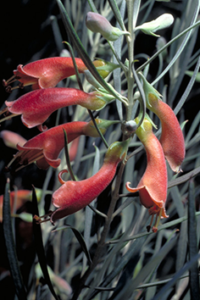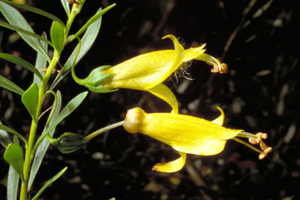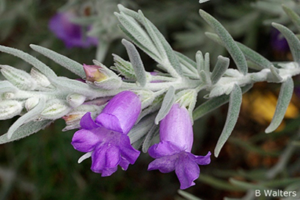Ian Cox from APS Parramatta Hills Group shares his enthusiasm for the Eremophila genus.
Eremophilas – they have it all!

Which genus of native plants:
- is quick growing and flowers early in its life?
- looks good in gardens?
- is hardy and drought-tolerant?
- grows in a range of soil types?
- is usually easy to propagate?
Well, eremophilas tick all these boxes. They also have a great variety of flower and foliage colours and textures. In garden design they can be used as feature plants, backgrounds, foregrounds or edgings. They can also be grown in pots. Many of them flower for long periods and attract small birds.
Where can you get eremophilas?
My own Group (Parramatta/Hills) has them for sale at meetings. In my locality, Plants Plus and Boongala Gardens have a small range. They can also be bought at the Collectors’ Plant Fair at Clarendon which is usually held in April each year. Another option is to buy them online, e.g. from the Australian Arid Lands Botanic Garden, Port Augusta. Another way is to join the Eremophila Study Group and participate in their exchange of plants and cuttings.
How many eremophilas are there?
A member of the Eremophila Study Group has compiled a spreadsheet with the names of all species, cultivars, hybrids and forms, together with photo links. The list has over 1,000 names!
Learning about eremophilas

Perhaps the best way to increase your understanding of this genus is to join the Eremophila Study Group. The Sydney sub-branch of the Eremophila Study Group has regular meetings and an email discussion group. Its members include enthusiasts who enjoy sharing their incredible knowledge. At recent meetings we have had a grafting demonstration, a keying exercise, discussions about propagation and the usual garden inspections and swapping of plants and cuttings. Members also receive the Eremophila Study Group newsletter which is a first-class publication full of great information and stunning photos. Members also have the opportunity to attend interstate conferences and field trips. The Eremophila Study Group’s website is here.
Growing eremophilas in Sydney
Many eremophilas grow well in Sydney on their own roots, especially the E. glabra and E. maculata forms and hybrids. There are lots of plants in this group to choose from, most of which would make a stunning addition to your garden. Some have fancy names like ‘Pink Pantha’ and ‘Mallee Lipstick’ just to make your imagination work overtime!

Some eremophilas don’t like Sydney’s summer humidity and rain (when it does rain!), and the usual answer to this is to grow these particular eremophilas as grafted plants. You can either purchase grafted plants or graft them yourself, usually using a hardy Myoporum as the rootstock. The basics are not too difficult, and can be learned by joining the Eremophila Study Group.
I’ve been growing eremophilas for close on 25 years and have been delighted with the results. In well-drained sunny positions eremophilas usually reward me for my efforts. The proportion of these plants in my garden has steadily increased, based solely on their good looks and overall performance. I have been fascinated and enthralled by their charm, and can thoroughly recommend them.
Addendum:
We were asked by a reader about pruning eremophilas. Question: I have an Eremophila glabra (Murchison Magic) that flowers all year round. I’ve never pruned this plant therefore it’s getting out of control and quite leggie. Could you please let me know when is the best time to prune this Eremophila of mine?
Answer from Ben and Ros Walcott: Most eremophilas do well with a good prune to keep them dense. The best time is when the flowering has slowed down but often that isn’t possible so just do it when you can. In Canberra we tend not to prune in the late autumn because the new growth gets hit by the frosts but otherwise, anytime seems OK. How hard to prune depends on the plant and the effect you are after. We know someone who cuts some to the ground but for us that is too radical. Pruning by up to ½ is not too radical.
Thanks to our readers and Ben and Ros Walcott for their answer.
